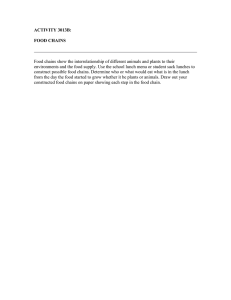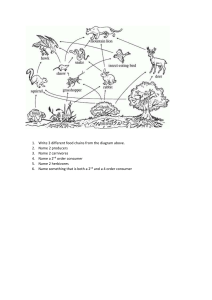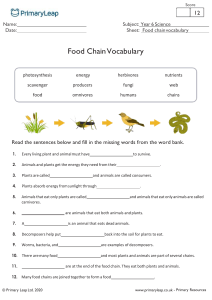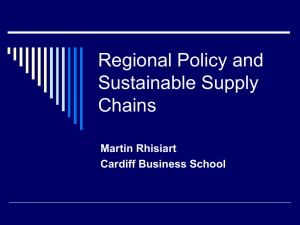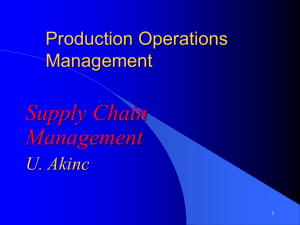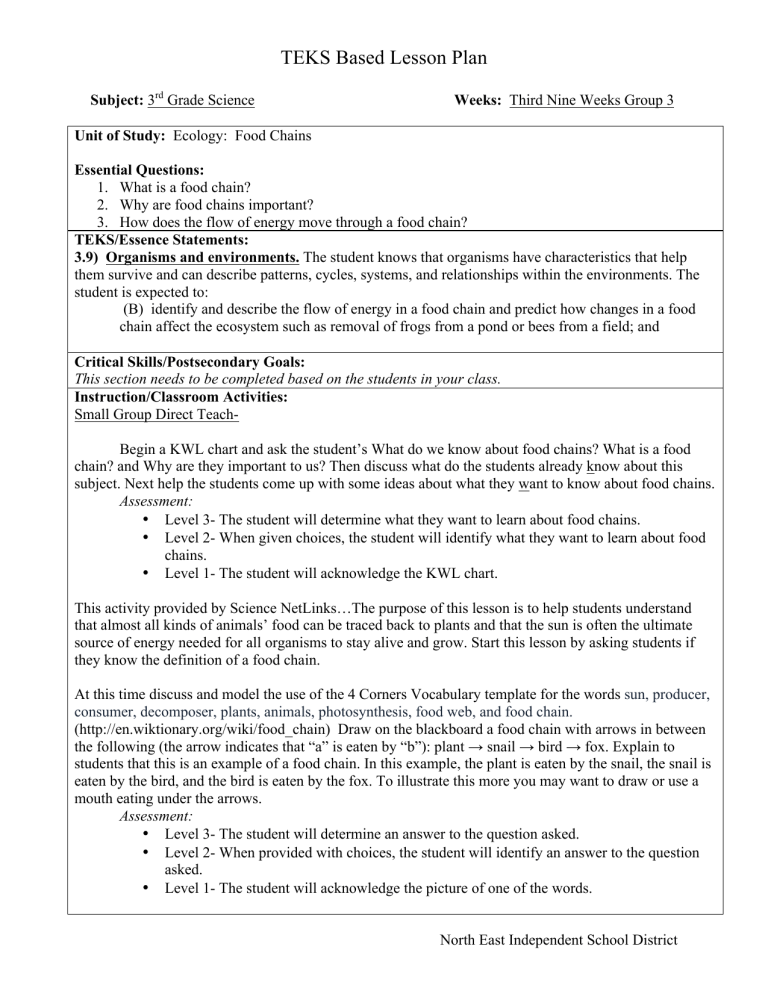
TEKS Based Lesson Plan Subject: 3rd Grade Science Weeks: Third Nine Weeks Group 3 Unit of Study: Ecology: Food Chains Essential Questions: 1. What is a food chain? 2. Why are food chains important? 3. How does the flow of energy move through a food chain? TEKS/Essence Statements: 3.9) Organisms and environments. The student knows that organisms have characteristics that help them survive and can describe patterns, cycles, systems, and relationships within the environments. The student is expected to: (B) identify and describe the flow of energy in a food chain and predict how changes in a food chain affect the ecosystem such as removal of frogs from a pond or bees from a field; and Critical Skills/Postsecondary Goals: This section needs to be completed based on the students in your class. Instruction/Classroom Activities: Small Group Direct TeachBegin a KWL chart and ask the student’s What do we know about food chains? What is a food chain? and Why are they important to us? Then discuss what do the students already know about this subject. Next help the students come up with some ideas about what they want to know about food chains. Assessment: • Level 3- The student will determine what they want to learn about food chains. • Level 2- When given choices, the student will identify what they want to learn about food chains. • Level 1- The student will acknowledge the KWL chart. This activity provided by Science NetLinks…The purpose of this lesson is to help students understand that almost all kinds of animals’ food can be traced back to plants and that the sun is often the ultimate source of energy needed for all organisms to stay alive and grow. Start this lesson by asking students if they know the definition of a food chain. At this time discuss and model the use of the 4 Corners Vocabulary template for the words sun, producer, consumer, decomposer, plants, animals, photosynthesis, food web, and food chain. (http://en.wiktionary.org/wiki/food_chain) Draw on the blackboard a food chain with arrows in between the following (the arrow indicates that “a” is eaten by “b”): plant → snail → bird → fox. Explain to students that this is an example of a food chain. In this example, the plant is eaten by the snail, the snail is eaten by the bird, and the bird is eaten by the fox. To illustrate this more you may want to draw or use a mouth eating under the arrows. Assessment: • Level 3- The student will determine an answer to the question asked. • Level 2- When provided with choices, the student will identify an answer to the question asked. • Level 1- The student will acknowledge the picture of one of the words. North East Independent School District TEKS Based Lesson Plan Then, tell them the following information about food chains: • A food chain shows who’s eating whom. • There are many food chains. • Usually a food chain begins with plants, thus they are at the bottom of the food chain. Next, using your computer and overhead projector, show students Food Chains, on the BBC website (http://www.bbc.co.uk/schools/ks2bitesize/science/living_things/food_chains/read1.shtml). Click “next” in the bottom right corner to go through the three sections. Once you’ve done the section on prey and predators, click on “Activity” in the bottom left corner to do the food chains activity with your students. Ask students to write the answers to the following questions to solidify what they just learned so that they can build upon this knowledge in the next section: (Keep in mind your STAAR-Alt Level 2 students will need chooses provided) • Why are green plants called producers? (They make their own food.) • Why are animals considered consumers? (They get their food from plants or other animals.) • What is a predator? (An animal that eats other animals.) • What is a prey? (The animal—"a consumer"—that is being eaten.) In this part of the lesson, students will explore the food chain in further detail. First, show the KLRN United Streaming Videos TLC Elementary: Life Cycle (Total Running Time: 24:26) [http://player.discoveryeducation.com/index.cfm?guidAssetId=74AE57B9-C6B7-495F-A6DBA2ED3829BDB7&blnFromSearch=1&productcode=DSCE] Then, using the Cycle of Life 1 student esheet, students should go to and watch Food Chain on National Geographic Explorer Brainpop (http://magma.nationalgeographic.com/ngexplorer/0309/quickflicks/). To begin, view the Food Chain movie. Click on “Play the Movie” to begin. At any time during the movie, you can select one of four icons (rewind, skip back, pause, skip forward) on the bottom right of the screen to review any information that you might have missed or didn’t understand. Additionally, you can wait until it is over and play the movie again. Assessment: • Level 3- The student will determine one thing they learned about food chains. • Level 2- When given choices, the student will identify one thing they learned about food chains. • Level 1- The student will acknowledge the video. Next, students should start the Chain Reaction activity on the EcoKids website. Have students read the activity instructions at the bottom of the page before doing the activity. This exercise is excellent because it ties together how disruptions in a food chain cause a particular "chain reaction" in the environment. Once there, click the “Play the Game” icon. Then click “Start” to begin the Chain Reaction! Click the “Next” button in the lower right corner to move through the screens and read information about the food chain. The final screen allows you to put two different food chains together: Northern Food Chain and Forest Food Chain. Choose the Northern Food Chain first. Once you are at that screen, use your mouse to click on and drag the parts of the food chain into the empty boxes. Be sure to put the objects in the right order to make the food chain! When you finish, click on “Test the Food chain” to see how you did. North East Independent School District TEKS Based Lesson Plan Next, a message will come up that asks: “What do you think will happen if you take the fish out of the food chain?” Click on the fish to find out! After you do the Northern Food Chain, click on the Forest Food Chain and do that one! Once students have watched the movie and gone through the Food Chain site and the Chain Reaction site activities, they should answer the corresponding questions on their Cycle of Life 1 student sheet. Answers to these questions can be found on the Cycle of Life 1 teacher sheet. Now students can do the Food Chains Quiz from the BBC site. This is a great review of everything that students have learned in this lesson. This quiz is self-explanatory and is made up of questions 1 through 14. The two main points of this lesson are that in food chains almost all kinds of animals’ food can be traced back to plants and that the sun is often the ultimate source of energy needed for all organisms to stay alive and grow. Finally, model the creation of a food chain and help the students to create/draw their own food chain. Post them somewhere where all students can view and benefit. Assessment: • Level 3- The student will generate their own food chain. • Level 2- When a partially filled in food chain is given, the student will complete their own food chain. • Level 1- The student will respond to the modeled food chain. Stations/CentersLevel 3 & 2 Stations: • Station: The student will go through magazines looking for items that can be used to create a food chain. • Station: The student will watch the video from National Geographic Explorer Brainpop called Food Chain. (http://www.brainpop.com/science/ecologyandbehavior/foodchains/) • Station: On Kidspiration, the students will create a food chain showing pictures of plants and animals, and how the flow of energy moves through a food chain. • Station: The students will search the school library for books on this topic then check them out to view. • Station: Word Wall Activities about the words sun, producer, consumer, decomposer, plants, animals, photosynthesis, food web, and food chain. (Refer to http://specialed.about.com/od/wordwalls/a/morewordwalls.htm, http://www.teachingfirst.net/wordwallact.htm, http://www.kllynch2000.com/wordwallactivites.html, http://www.teachingfirst.net/wordwall.htm) North East Independent School District TEKS Based Lesson Plan Level 1 Stations: • Station: The student will acknowledge the video from National Geographic Explorer Brainpop called Food Chain. (http://www.brainpop.com/science/ecologyandbehavior/foodchains/) Individualized Communication Planning: This section needs to be completed based on the individualized communication needs of the students in your class. Differentiated Tasks: Level 3 Level 2 Level 1 ¨ The student will ¨ When given choices, the ¨ The student will determine what they student will identify what acknowledge the KWL want to learn about food they want to learn about chart. chains. food chains. ¨ The student will ¨ The student will ¨ When provided with acknowledge the picture determine an answer to choices, the student will of one of the words. the question asked. identify an answer to the ¨ The student will ¨ The student will question asked. acknowledge the video. determine one thing ¨ When given choices, the ¨ The student will respond they learned about food student will identify one to the modeled food chains. thing they learned about chain. ¨ The student will food chains. generate their own food ¨ When a partially filled in chain. food chain is given, the student will complete their own food chain. Materials/Resources: • Create a KWL chart; You may us the KWL Smart Notebook file already created for you. • 4 Corners Vocabulary template & internet resources • The KLRN United Streaming Videos TLC Elementary: Life Cycle (Total Running Time: 24:26) [http://player.discoveryeducation.com/index.cfm?guidAssetId=74AE57B9-C6B7-495F-A6DBA2ED3829BDB7&blnFromSearch=1&productcode=DSCE] • The Food Chains activity, on the BBC website (http://www.bbc.co.uk/schools/ks2bitesize/science/living_things/food_chains/read1.shtml) • The Food Chain video on National Geographic Explorer Brainpop (http://magma.nationalgeographic.com/ngexplorer/0309/quickflicks/) • The Chain Reaction activity on the EcoKids website • Cycle of Life 1 student activity sheet • Cycle of Life 1 teacher sheet • Food chain quiz from the BBC site • Chart paper • Magazines • Markers, glue, scissors • Smartboard software • Kidspiration software • Digital camera North East Independent School District TEKS Based Lesson Plan • Science Notebooks for the students to draw in or add pictures *Materials need for stations are not listed, and may or may not be included as provided materials. Assessment Strategies: This section needs to be completed based on the strategies appropriate for the students in your class. IEP Connections: This section needs to be completed based on the IEPs documented in the students’ ARDs in your class. Work Cited Information: • KLRN United Streaming Videos • Wikipedia’s Free On-line Encyclopedia (http://en.wikipedia.org/wiki/) • Picture dictionaries (http://dictionary.reference.com/) • News-2 You related materials 1997-2008 News-2-You, Inc. Symbolstix, LLC used with permission. (http://en.wikipedia.org/wiki/ or http://news2you.n2y.com/) • All Smart Notebook Activities from Smart Exchange (http://exchange.smarttech.com/index.html#tab=0) • Science NetLinks (http://sciencenetlinks.com/lessons/materials-1-materials-and-manufacturing/) • National Geographic Explorer Brainpop & Brainpop Jr. (http://magma.nationalgeographic.com/ngexplorer/0309/quickflicks/) • EcoKids website • BBC website (http://www.bbc.co.uk/schools/ks2bitesize/science/living_things/food_chains/read1.shtml) • NEISD Science Program Support Document North East Independent School District
